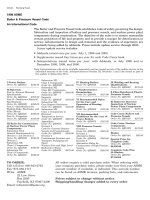Process Engineering Equipment Handbook 2009 Part 17 doc
Bạn đang xem bản rút gọn của tài liệu. Xem và tải ngay bản đầy đủ của tài liệu tại đây (1.99 MB, 80 trang )
Storage Tanks for Liquids*
Specification: Factory coated, bolted steel for potable and process water storage
I. General
A. Scope of Work
Design and supply factory-coated, bolted steel water/wastewater storage tank(s),
complete with assembly hardware, gasket, sealant, and accessories as shown on
the contract drawings and described herein.
B. Tank Supplier
1. The engineer’s selection of the products herein specified are predicated on a
thorough examination of design criteria, construction methods, and
comparative extended life-cycle analysis. Deviations from the specification
will not be permitted except as noted in I.B.3 below.
2. Tank(s) to be used in the contract is (are) to be 100 percent new material,
and is (are) manufactured by A.O. Smith Engineered Storage Products
Company (ESPC) of Parsons, Kansas, USA.
3. Alternate tank products will be considered for approval by the engineer.
Without exception, manufacturer shall maintain a current ISO-9001
certification. Approval submittals shall include:
a. A reference list of five tanks presently in service of similar size and
application operating satisfactorily for a minimum of five years.
b. Technical information covering tank materials, designs, and coatings.
c. Copy of manufacturer’s current active ISO-9001 Quality System Certificate.
d. Due to the potential aggressive corrosive nature of the products being
stored, submittals will be required to be accompanied by statements of
suitability for the specific intended purpose of this project covering
coatings, gaskets, sealants, and hardware protection.
C. Submittal Drawings
The tank supplier shall furnish for the approval of the engineer, at no increase
in contract price, three complete sets of construction drawings. When approved,
one set of such prints will be returned to the bidder marked “Approved,” and
these drawings will then govern the work detailed thereon. The approval by the
engineer of the supplier’s drawings shall be an approval relating only to their
general conformity with the project requirements and shall not guarantee detail
dimensions and quantities.
II. Design Criteria, Codes, and Standards
A. Tank Capacity
Tank shall have a (nominal) (minimum) capacity of ________ (U.S. Gallons)
(Imperial Gallons) (Cubic Meters) (Liters).
B. Tank Dimensions
The tank shall have a nominal diameter of ________ (feet) (meters) with a shell
height of ________ (feet) (meters).
C. Tank Design Standards
1. The tank shall be designed as an atmospheric unit that operates on an
equalized pressure, internally and externally. It shall be circular, constructed
of carbon steel, and shall be designed in accordance with American Petroleum
Institute (API) specification 12B principles (Specification for Bolted Tanks
for Storage of Production Liquids) or American Water Works Association
Tanks T-9
* Source: A.O. Smith Engineered Storage Products Company, USA.
specification ANSI/AWWA D103-87 (Factory-Coated Bolted Steel Tanks for
Water Storage). Bolted joints shall conform to API standard 12B. High-
strength steel may be used in accordance with III.A.1 below.
2. The tank shall be provided with (select one):
an integral steel bottom, both sides of which shall be coated in accordance
with Section 10.5 of the AWWA D103 specification.
a reinforced concrete floor (by others) with the tank walls embedded in the
concrete.
3. If a deck is required, it shall be an integral steel deck, the underside of
which shall be coated in accordance with Section 10.5 of the AWWA D103
specification. At the engineer’s discretion and specification, a geodesic
aluminum dome may be supplied.
D. Design Loads
1. Specific gravity: ________ (Minimum 1.00).
2. Maximum wind velocity: ________ (mph) (kph).
3. Roof Live Load: ________ (psf) (kg/m
2
).
4. Earthquake (select one):
Seismic zone (1) (2) (3) per AWWA D103 using Fixed Percentage Method.
Seismic zone 4 (nonessential) (essential) per AWWA D103 using
pseudodynamic approach.
5. Tank to store ________________________.
6. Stored product temperature (degrees F): maximum ________ minimum
________ normal ________.
7. Stored product pH range: maximum ________ minimum ________ normal
________.
III. Materials Specifications
A. Plates and Sheets
1. Steel plate shall conform to, or at a minimum shall be equal to, the
requirements of ASTM A36 with a minimum yield strength of 36,000 psi.
High-strength plate shall conform to, or at least be equal to, the requirements
of ASTM A572-Gr 50 or 60, ASTM A607-Gr 50, 60, or 70.
2. Steel sheet shall conform to, or at a minimum shall be equal to, hot-rolled
quality per ASTM A570 Gr 40 with a minimum yield strength of 40,000 psi.
Minimum thickness shall be 12 gauge (nominal 2.65 mm).
B. Rolled Structural Shapes
1. Rolled structural shapes shall conform to ASTM A36.
C. Horizontal Wind Girders
1. When intermediate wind girders are required, the girders shall be either
rolled structural shapes or a truss design of equivalent strength, coated the
same as the tank exterior.
D. Hardware
1. Bolts used in tank joints shall be 1/2-in diameter and shall meet the
minimum requirements of API-12B, Appendix A, and AWWA D103, Section
2.2.
2. Bolts shall conform to ASTM A307, ASTM A325, ASTM A490, or API-12B, as
required by the tank design.
3. Bolts shall be mechanically galvanized to Class 50 of ASTM B695, or hot dip
galvanized to ASTM A153. Nuts shall be hot dip galvanized to ASTM
A153.
T-10 Tanks
4. All bolts in contact with the stored liquid shall be provided with synthetic
gasket-backed steel washers for placement between the nuts and the steel
sheets. Other joints shall have steel flat washers under the nuts to protect
the external coatings. Shell hardware exposed on the interior of the tank shall
be plastic covered to protect against corrosion. If the tank is located in a
coastal or corrosive industrial area, exterior hardware shall be plastic
covered.
5. Gaskets and/or sealants shall conform to AWWA D103 Section 2.10.
IV. Coatings
A. Cleaning
1. Following fabrication, parts shall be thoroughly cleaned by a detergent
wash/clean water rinse process followed immediately by hot air drying.
B. Surface Preparation
1. Following the wash/rinse and drying, the parts shall be steel grit blasted to
a near-white finish SSPC-SP 10 (SA 2.5).
2. The surface anchor pattern shall not be less than 1.0 mil (25 microns).
C. Coating
1. All parts shall be factory coated after blasting; no shaping, bending,
punching, flanging, or grinding may be done on the steel after blasting and
before coating. Field coating, except for touchup, will not be permitted.
2. Interior coatings shall be Thermo-Thane 7000
TM
in accordance with AWWA
D103 Section 10.5 and shall be NSF approved. Exterior coating system shall
be (select one):
Polyamide epoxy primer with acrylic enamel topcoat.
Polyamide epoxy primer with acrylic urethane topcoat.
System 4
TM
consisting of an inorganic zinc prime coat, two intermediate
coats of polyamide epoxy, and a finish coat of acrylic urethane.
3. Exterior color shall be (white) (light blue) (light green) (tan) (light gray).
D. Inspection
1. All coated parts shall be inspected prior to shipment, and shall be marked
with a part number that shall correspond to the appropriate tank erection
drawings to clarify and simplify tank assembly.
2. All coated sheets and parts shall be inspected for color uniformity.
3. A representative sampling of coated sheets shall be inspected in accordance
with AWWA D103, Section 10.5.3 to verify minimum coating dry film
thicknesses.
V. Appurtenances
A. The tank supplier shall furnish the appurtenances as shown on the engineer’s
drawings or as approved equal.
B. Unless otherwise noted, appurtenances shown on drawings shall be as follows:
1. Hatch. The tank roof hatch shall have a curbed, upward opening 24-in square
manway. The curb shall extend at least 4 in above the tank. The hatch cover
lip shall be hinged and provisions made for locking. The hatch cover lip shall
extend for a distance of 2 in down on the outside of the curb. The hatch and
cover shall be hot dip galvanized to ASTM A123.
2. Inlet and outlet connections. Inlet, outlet, and overflow connections shall
conform to the sizes and locations specified on the plan sheets. All pipe
Tanks T-11
connection openings are to be cut into the steel panels in the factory before
coating preparation and application unless otherwise specified by the
engineer.
3. Vent. The free air vent shall be a mushroom-screened vent of sufficient size
to accommodate normal inlet and outlet water flow (flow specified in plan
sheets). The overflow pipe shall not be considered to be a tank vent. The vent
shall be so designed and constructed as to prevent the entrance of birds or
animals.
4. Outside tank ladder. An outside ladder with lockable hoop shall be hot dip
galvanized and shall meet or exceed OSHA requirements.
5. Deck perimeter guardrail. A deck perimeter guardrail shall be galvanized
and shall meet or exceed OSHA requirements. Guardrail shall have top rail,
midrail, and toeboard.
6. Shell manhole. The shell manhole shall be circular, 24 inches in diameter,
and shall include an extended neck for ease in cover removal and
replacement. If the manhole cover weighs more than 50 lb, a cover hinge shall
be provided.
VI. Shipping
A. All plates, supports, members, and miscellaneous parts shall be packaged for
shipment in such a manner as to prevent abrasion or scratching of the finished
coating.
1. Wall sheets shall be placed in disposable racks to separate adjacent
sheets.
2. Deck and bottom sheets shall be stacked and bolted together.
3. Structural steel members shall be skidded and banded.
4. Miscellaneous small parts and hardware shall be boxed and crated.
5. Odd shaped parts, if not boxed or skidded, shall be individually secured.
B. For ocean shipments, if shipped as break-bulk cargo, all items shall be full box
export crated. For containerized shipments, the following shall apply:
1. Wall sheet racks shall be blocked and braced.
2. Deck and bottom sheet stacks shall be full box crated and blocked and braced.
3. Structural steel members shall be full box crated and blocked and braced.
4. Miscellaneous small parts and hardware shall be crated, blocked, and braced.
5. Odd shaped parts not conducive to packing shall be individually blocked and
braced.
VII. Erection
Field erection of factory-coated bolted steel tanks shall be in strict accordance
with the manufacturer’s recommendations. Particular care shall be exercised in
handling and bolting of tank panels, supports, and members to avoid abrasion
or scratching of coating. Touchup coating shall be done in accordance with
manufacturer’s recommendations.
VIII. Testing
1. Following completion of erection and cleaning of tank, it shall be tested for liquid
tightness by filling the tank to its overflow elevation.
2. Any leaks disclosed by this test shall be corrected by the erector in accordance
with the manufacturer’s recommendations.
T-12 Tanks
3. Water required for testing shall be furnished by owner without change at the
time of erection completion.
IX. Foundations
1. The tank foundation is not a part of the tank supply contract.
2. The tank foundation shall be designed by the owner’s engineer to safely sustain
the structure and its live loads.
3. The foundation is to meet the requirements of AWWA D103. The top of the
foundation shall be a minimum of 6 in (150 mm) above the finished grade, unless
specified otherwise by the purchaser. Tanks that require anchor bolts shall be
supported on a concrete ringwall or slab. Where steel floor sits directly on
concrete, tank pad (1/2-in-thick cane-fiber joint filler to ASTM D1751) shall be
supplied by tank manufacturer. The tank foundation shall be (select one):
Type 1. Tanks supported on ringwalls.
Type 2. Tanks supported on concrete slabs.
Type 3. Tanks within ringwalls.
Type 4. Tanks supported on granular berms.
Type 5. Tanks supported on granular berms with steel retainer rings. Steel
retainer rings to be supplied by tank manufacturer.
Type 6. Tanks without steel floors supported on a concrete slab. Wall-to-
slab connection details shall be in accordance with the manufacturer’s
recommendations. Installation of the foundation, bottom tank ring, and
sealing of the tank wall to the slab shall be the responsibility of the general
contractor or owner.
X. Warranty
The tank manufacturer shall warrant the tank against any defects in workmanship
and materials for a period of one year from the date of shipment. In the event any
such defect should appear, it shall be reported in writing to the manufacturer during
the warranty period.
Tank Gauges*
What is tank gauging?
Tank gauging is the generic name for the static quantity assessment of liquid
products in bulk storage tanks.
Two methods are recognized:
A volume-based tank-gauging system: quantity assessment based on level- and
temperature measurement.
A mass-based tank-gauging system: quantity assessment based on hydrostatic
pressure of the liquid column measurement.
Whatever method is used, a high degree of reliability and accuracy is of paramount
importance when data are used for inventory control or custody transfer
purposes.
Tanks T-13
* Source: Enraf, UK.
Refineries, chemical plants, terminals, and independent storage companies make
use of bulk storage tanks for storage of liquid or liquefied products:
Common bulk storage tanks are aboveground vertical cylindrical or spherical
tanks.
Vertical cylindrical tanks can be categorized as fixed roof tanks, with either a cone
or dome roof construction, or floating roof tanks.
Underground storage facilities such as caverns are used in areas where the soil
structure permits this.
In order to reduce the vapor losses of fixed roof tanks they can be fitted with internal
floating roofs or screens.
Liquefied gases are stored under pressure in spherical tanks, cylindrical vessels,
or under refrigerated or cryogenic conditions in specially designed, well-insulated
tanks.
Typical capacities of bulk storage tanks range from 1.000 m
3
(6300 bbl) to more
than 120,000 m
3
(755,000 bbl). The value of the products stored in those tanks
amounts to many millions of dollars.
A level uncertainty of only 1 mm (0.04 in) or 0.01 percent in a 10 m (33 ft) tall,
50.000 m
3
tank (315,000 bbl), equals 5 m
3
(31 bbl). Hence accuracy is a prime
requisite for good inventory management; however, it is only one of the many
aspects involved in tank gauging. Reliability to prevent product spills and safety of
the environment and personnel are equally important.
The following listings show a number of requirements for tank-gauging systems.
General requirements for a tank-gauging system
Safety
Accuracy and repeatability
Reliability and availability
Compatibility with operations
Stand-alone capabilities
Operator-friendly
Low maintenance
Easy to expand
Additional requirements
First-order failure detection
Accepted for custody transfer and legal purposes (duties, royalties)
Compatible with standards (API, etc.)
Interface to host computer
Software support
Upgradability
Service and spares support
Acceptable price/performance ratio
Vendor’s quality assurance procedures (ISO 9000)
Manuals and documentation
T-14 Tanks
Why tank gauging?
Tank gauging is required for the assessment of tank contents, tank inventory
control, and tank farm management. System requirements depend on the type of
installation and operation.
The following types of operation, each having its own specific requirements, can
be categorized:
Inventory control
Custody transfer
Oil movement and operations
Leak detection and reconciliation
Inventory control. Inventory control is one of the most important management tools
for any refinery, terminal, or storage company. Inventory represents a large amount
of assets for each company. Tank inventory control is either based on volume or
mass. However, neither volume nor mass is the sole solution for accurate and
complete inventory control. Products received, internal product transfers, and
delivered products of refineries, chemical plants, and terminals are quite commonly
measured in often incompatible volumetric or mass-based units.
Conversions from volume to mass and vice versa have to be frequently made, so
that all measuring parameters such as product level, water interface, density, and
temperature measurements are equally important.
The combination of volume and mass as realized in hybrid systems provides the
most attractive solution.
In-plant accuracy requirements for inventory control are often noncritical. The
measurement uncertainties do not result in direct financial losses. Reliability and
repeatability are much more important.
Independent storage companies and terminals that strictly store and distribute
products, owned by their customers, cannot operate without an accurate inventory
control system. Such systems should be very reliable and accurate and provide all
inventory data.
Custody transfer. Many installations used their tank-gauging system for the
measurements of product transfers between ship and shore and/or pipeline
transmission systems. A tank-gauging system is a very cost-effective and accurate
solution compared to flow metering systems, especially when high flow rates are
present and large quantities are transferred. When flow measuring systems are
used, however, the tank-gauging system offers a perfect verification tool.
Where custody transfer or assessment of taxes, duties, or royalties are involved,
the gauging instruments and inventory control system are required to be officially
approved and certified for this purpose. In countries where such legal certification
does not yet apply, verification of the measurements is often carried out by
surveying companies. They generally use dip tapes, portable thermometers and
sampling cans to measure level, temperature, and density prior to and after the
product transfers. This is labor intensive and requires considerable time.
Surveyors use the same procedures to calculate volumes or mass as do modern
tank-gauging systems. Hence the presence of a reliable, certified accurate tank-
gauging system facilitates their surveys and will reduce the turnaround time.
Another advantage is that in those cases where the quantity of product transferred
is determined on the basis of opening and closing tank measurements, some
systematic errors are canceled out. Hence the uncertainty of such transfer
Tanks T-15
measurements is better than can be expected on the basis of uncertainties specified
for tank inventory.
Oil movement and operations. Generally tank content measurements for day-to-day
operational use, for scheduling purposes, and for blending programs do not require
the same accuracy as custody transfer operations. However, measurement
reliability and repeatability are important. Reliable level alarms are also a must to
operate safely. A high degree of accuracy and reliability will allow operations to
safely use the maximum tank capacity. Past experience indicates that a 5 percent
storage capacity gain can be achieved.
Oil movement and operations generally have very strict equipment requirements.
They specify compatibility with their supervisory control and management systems.
Operations will use availability and easy maintenance as the main criteria for
selection of equipment. Cost of ownership calculations, however, can provide
excellent insights into the selection or evaluation of alternative instrument and
measurement techniques. Still, the user of these types of calculations should be
careful to use only correct and valid arguments. For example, including the price
of a stilling well in a comparative study for level gauges can be inappropriate if
such a well is already part of the tank construction. Additionally, better
performance, in terms of higher accuracy and lower maintenance, needs to be
valued.
For oil movement and operations, either mass or volume measurement
techniques can be used. Volume can be derived from level only; mass can be
measured directly by means of pressure transmitters. Additional information can
be obtained by measuring vapor temperature and pressure. Density measurement
can also be added, with accuracies from 0.5 percent up to 0.1 percent. Whichever
technique is selected, it should be compatible with the operations of all parties using
the data from the tank-gauging system.
As stated earlier, plant management and control systems can facilitate oil
movement and operations. Maintaining data integrity from the field to the receiving
system is essential. A high degree of integration of the transmission of field
instruments is a prerequisite. However, as long as a worldwide standard for digital
communications is missing, different protocols will be in use.
Leak detection and reconciliation. For many decades the oil industry has been
concerned with the financial consequences of oil losses. In recent years, there has
also been an increased awareness of the industry’s environmental impact. Pollution,
caused both by liquid spills and atmospheric emissions, is an area of increased
concern, and the industry has initiated programs to reduce the risks of
environmental damage. Maintaining an accurate leak detection and reconciliation
program is a necessity for any environmentally conscious tank farm owner.
At the fourth Oil Loss Control Conference in 1991, organized by the Institute of
Petroleum in Great Britain, several leading authorities presented papers on nearly
every aspect of loss control.
Dr. E. R. Robinson, consultant to the IP Refining Loss Accountability Committee,
showed with a survey of 11 major UK refineries that an “average” refinery could
have yearly losses of 0.56 percent of the total input quantity.
An accurate, reliable tank-gauging system helps to quantify and identify the
source of these losses and offers the tools to prevent losses, or at least reduce them.
Another paper presented by Dr. J. Miles (SGS Redwood Ltd.) formulated an
interesting approach to loss uncertainty assessment. Stock is mainly determined
on the basis of tank measurement; however, inputs and outputs can also be assessed
via flow (either volume or mass) and weighing bridge. Reconciliation of both
T-16 Tanks
measurements holds the key to reliable inventory control and effective loss
control.
A hybrid inventory measurement system (HIMS) combines mass- and volume-
based inventory systems, improving the reliability and reducing uncertainties of
the overall balance.
Tank-gauging techniques
Tank gauging has a long history. Since each user and every application has its own
specific requirements, several measurement techniques and solutions to gauge tank
contents are currently available.
Manual gauging. Tank gauging started with manual gauging (Fig. T-7), using a
graduated diptape or dipstick. This technique is still used worldwide, and is today
still the verification for gauge performance calibration and verification.
The typical accuracy of a diptape used for custody transfer measurements is often
specified as ± (0.1 + 0.1 L) mm [equal to ± (0.004 + 0.0012 L¢) in] for the initial
calibration of new diptapes. In the metric formula, L is the level in meters, and in
the ft and inch formula, L¢ is the level in ft. For tapes in use, the recalibration
accuracy applies. This accuracy is twice the uncertainty of a new tape.
But the tape uncertainty is not the only cause of error. Accurate hand dipping is
a difficult task, particularly with high winds, cold weather, during night, or when
special protection equipment has to be used. Additionally, a human error, of at least
±2 mm (±0.08 in), has to be added to the tape readings. API Standard 2545 is
dedicated completely to manual tank gauging.
Another disadvantage of manual tank gauging is that employees are often not
allowed to be on a tank because of safety regulations, resulting in costly, long
waiting times.
Tanks T-17
FIG. T-7 Manual gauging. (Source: Enraf.)
Float and tape gauges. The first float and tape gauges, also called automatic tank
gauges, were introduced around 1930. These instruments use a large, heavy float
in order to obtain sufficient driving force. Initially the float was connected via a
cable to a balance weight with a scale and pointer along the tank shell indicating
the level. Newer versions had the float connected, via a perforated steel tape, to a
“constant” torque spring motor. The perforations drive a simple mechanical counter
that acts as a local indicator. Typical accuracy of a mechanical gauge is in the range
of 10 mm (1/2 in). Due to the mechanical friction in pulleys, spring motor, and
indicator, the reliability is poor.
Remote indication is possible via an electronic transmitter coupled to the
indicator. However, this will not improve the reliability or accuracy of the
mechanical gauge.
One of the major disadvantages with float-driven instruments is the continuous
sudden movement due to the turbulence of the liquid gauged. These movements,
which can be rather violent, cause a continuous acceleration and deceleration of the
drive mechanism, resulting in excessive wear and tear of the local indicator,
transmitter, and other devices coupled to the gauge. The reversing motions and
accelerations cannot be followed by the indicating system and transmitter. Often
the gear mechanism, driving the indicator and transmitter shaft, disengages,
resulting in erroneous readings and desynchronization of the transmitter. This
leads to considerable maintenance and lack of measurement reliability. In light of
the present worldwide concern to prevent product spills, these gauges should no
longer be used. Because of their low price, however, a large share of the world’s
tanks are still equipped with these instruments. See Fig. T-8.
Servo gauges. Servo tank gauges (Fig. T-9) are a considerable improvement over
the float-driven instruments. They were developed during the 1950s. In this gauge,
the float is replaced by a small displacer, suspended by a strong, flexible measuring
wire. Instead of a spring motor, servo gauges use an electrical servo motor to raise
and lower the displacer. An ingenious weighing system continuously measures the
T-18 Tanks
FIG. T-8 Float and tape gauge. (Source: Enraf.)
weight and buoyancy of the displacer and controls the servo system. The motor also
drives the integral transmitter.
Mechanical friction in the servo system, transmitter, local indicator and alarm
switches has no effect on the sensitivity and accuracy of the gauge. Also, turbulence
has no direct effect. An integrator in the servo control system eliminates the effects
of sudden product movements. The gauge not only produces an average level
measurement under turbulent conditions, but it also eliminates unnecessary
movements and reduces wear and tear, greatly extending the operational life of the
instrument.
The original servo gauge does not look much like today’s modern version. The
instruments have evolved into highly reliable mature products, and are gradually
replacing mechanical float gauges, cutting down on maintenance and improving on
inventory results. Modern intelligent servo gauges have very few moving parts,
resulting in long-term reliability and accuracy. They also have a high degree of data
processing power.
The instruments do not merely measure the liquid level but are also capable of
measuring interface levels and product density.
Accurate, programmable level alarms are standard. Accuracies of better than
1 mm (1/16 in) over a 40-m (125-ft) range can be attained.
The exceptional accuracy and reliability has resulted in the acceptance of the
measurements and remote transmission, by Weights & Measures and Customs &
Excise authorities in many countries.
Radar gauges. The use of radar to measure product levels in storage tanks is one
of the most recent techniques. Radar level gauges were developed in the mid-sixties
for crude carriers. The majority of these ships were equipped with mechanical float-
Tanks T-19
FIG. T-9 Servo gauge. (Source: Enraf.)
driven gauges. The level gauges were only used when the ship was ashore, loading
or unloading. New safety procedures for tank washing with closed tanks during the
return voyage, and the necessity to fill the empty tank space with inert gas, made
nonintrusive measurements preferable. Accuracy was less important for the level
measurement of the cargo tanks, since custody transfer and fiscal measurements
used the certified level gauges or flow meters of the shore installation.
Radar level gauges do not have moving parts and only an antenna is required in
the tank. This results in very low maintenance cost. Although the investments costs
are higher when compared to float gauges, the cost of ownership will be considerably
lower.
The radar instruments use microwaves, generally in the 10 GHz range, for the
measurement of the liquid level. The distance the signal has traveled is calculated
from a comparison of transmitted and reflected signals. With tank gauging,
relatively short distances have to be measured. Electromagnetic waves travel
with nearly the speed of light. Because of the short distances ranging from
some centimeters (inches) to, e.g., 20 m (66 ft), and the required resolution, a
measurement based on time is almost impossible. The solution is to vary the
frequency of the transmitted signal and measure the frequency shift between
transmitted and reflected signal. The distance can be calculated from this frequency
shift.
Now radar level gauges are available for product storage tanks found in
refineries, terminals, chemical industries, and independent storage companies. The
absence of moving parts, their compact design, and their nonintrusive nature result
in low maintenance costs and make them very attractive. In order to achieve an
accuracy ten times better than for use in marine applications, specific antennas and
full digital signal processing have been applied.
Older radar instruments were equipped with large parabolic or long horn
antennas, whereas the modern radar level gauges use planar antenna techniques.
These antennas are compact and have a much better efficiency, resulting in
excellent accuracy.
Several antenna types are available to suit virtually every tank configuration:
Free space propagation is the most common method and is used if the gauge is
installed on top of a fixed roof tank (Fig. T-10).
T-20 Tanks
FIG. T-10 Radar level gauge of free space measurement. (Source: Enraf.)
On floating roof tanks, the radar gauge can be installed on the guide pole. A
specific radar signal (circular mode signal) is than guided via the inner shell of
the guide pole or support pipe (Fig. T-11).
Radar gauges can also be used on high-pressure storage vessels. An isolation
valve can be installed between the vessel and the instrument. Verification and
calibration is possible while the instrument remains in service.
Accurate measurement on products with very low vapor pressures is possible with
the latest radar gauging technique.
Radar gauges are also a logical choice for tanks containing highly viscous
products, such as blown asphalts, contaminating products, and liquids that are very
turbulent.
Hydrostatic tank gauging. Hydrostatic tank gauging (HTG) is one of the oldest
techniques to measure the tank contents. In the process industry, level measurement
using differential pressure transmitters is very common. Normally this method uses
analog pressure transmitters, with a 1 percent accuracy. Inventory measurement
requires a much better accuracy; therefore, analog transmitters are not suitable for
this purpose.
Specially calibrated smart digital pressure transmitters are now available to
provide much better accuracy. The onboard microprocessor allows compensation for
temperature effects and systematic transmitter deviations. HTG makes use of these
accurate pressure transmitters for a continuous mass measurement of the tank
contents (Fig. T-12).
Various HTG configurations are available:
A simple HTG system can be built with only a single transmitter near the tank
bottom (P1). The total mass can be calculated by multiplying the measured
pressure by the equivalent area of the tank.
By adding a second transmitter (P2) at a known distance from P1, the observed
density (dens. obs.) of the product can be calculated from the pressure difference
P1 - P2. The level can be calculated from the density and the P1 pressure.
Tanks T-21
FIG.
T-11 Radar level gauge for stilling well measurement. (Source: Enraf.)
A P3 or top transmitter can be added to eliminate the effect of the vapor pressure
on the P1 and P2 transmitters.
For pressurized tanks, HTG is less suitable. The large difference between the
storage pressure and small hydrostatic pressure variations (turndown ratio) causes
inaccurate results. Also, the fitting of the transmitter nozzles on spheres is costly
and often unacceptable.
On atmospheric tanks, HTG systems offer a 0.5 percent uncertainty or better for
the mass measurement. The accuracy of the HTG level measurement, although
sufficient for the determination of the equivalent area, is 40 to 60 mm (1
1
/
2
to
2 in) and totally unacceptable for custody transfer or inventory assessment. Hence
many companies require the addition of a dedicated level gauge.
A drawback of the HTG system is that its density measurement is only over a
limited range near the bottom of the tank. If the liquid level is above the P2
transmitter, the calculated value is based on active measurements. However, if the
level is under P2 there is no differential pressure measurement. This will be the
case when the level is only 1.5 to 2.5 m (6 to 8 ft) above the tank bottom. With many
tanks, the density in the heel of the tank will be different from the density at higher
levels. This density stratification has a devastating effect on the calculated values
for level and volume. Since the level measurement of a HTG system is very
inaccurate, it becomes worthless for any form of overfill protection. Secondary high
level alarms are essential.
Hybrid inventory measurement system. The hybrid inventory measurement system
(HIMS) combines the most modern level gauging techniques with hydrostatic
tank gauging (Figs. T-13 and T-14). It utilizes an advanced radar or servo level
gauge for accurate level measurement, with a smart pressure transmitter (P1) and
a temperature measurement instrument. On nonatmospheric tanks a second
transmitter for the vapor pressure compensation is required.
The level measurement is the basis for an accurate volume inventory calculation.
The pressure measurement, combined with the level, provides a true average
density measurement over the entire level height. This average density is used for
T-22 Tanks
FIG.
T-12 Hydrostatic tank gauging system. (Source: Enraf.)
the mass assessment. The temperature is used to calculate standard volumes and
densities at reference temperatures.
Advanced servo gauges and radar gauges can be provided with an interface board
that communicates directly with the smart pressure transmitter. The result is a
unique and very complete measurement providing level, interface levels, product-
water interface levels, average density, average temperature, vapor temperature,
and alarms.
Existing installations with advanced radar or servo level gauges can, in most
cases, easily be extended to become a HIMS system.
Tanks T-23
FIG. T-13 HIMS systems with radar or servo level gauge. (Source: Enraf.)
FIG. T-14 Upper part of a HIMS installation. (Source: Enraf.)
HIMS is often called “The best of both worlds,” providing the best of level gauging
combined with the best of hydrostatic gauging.
Quantity assessment in tank gauging
The uncertainties of quantity assessment of a tank-gauging system depend on the
measuring uncertainties of the installed instruments, tank capacity table (TCT) and
installation.
Level gauging instruments measure the liquid level in the tank. Pressure
transmitters measure the hydrostatic pressure of the liquid column. Both level and
pressure are primary functions for the calculation of volume and mass, respectively.
Hybrid systems, such as HIMS, use both inputs in one system. Conversions from
volume to mass or vice versa are made using density and temperature as secondary
inputs. The density input may be obtained from an outside source, such as a
laboratory, or may be measured in the tank by using pressure transmitters or servo
density. The temperature input is obtained from a temperature-measuring system
in the tank.
How the individual errors influence a mass or volume uncertainty depends on
the type of quantity assessment.
Level-based quantity assessment. Figure T-15 shows how the quantity assessment
in a conventional-level (volume)—based system is accomplished.
The tank references, liquid level, liquid temperature, and liquid density are the
relevant parameters.
Level is measured using a radar or servo level gauge.
Temperature is measured using a spot or average temperature sensor.
Density at reference temperature is obtained from a laboratory analysis of a grab
sample.
T-24 Tanks
FIG.
T-15 Level-based quantity assessment. (Source: Enraf.)
The gross observed volume (GOV) is derived from level and the TCT.
The gross standard volume (GSV) is calculated from the GOV, corrected with the
volume correction factor (VCF).
The VCF is derived from the temperature measurement using ASTM Table 54
and the density at reference temperature (DENS. REF.).
The total MASS is calculated from the GSV multiplied by the DENS. REF.
The MASS of the product can also be calculated from the net standard volume as
the GOV minus sediment contents and water.
Major causes for uncertainties are the temperature assessment and the TCT.
Additional functionality can be added to enhance the total performance, e.g., vapor
pressure and water interface measurement.
Hydrostatic-based quantity assessment. The quantity assessment of a HTG-based
system is shown in Fig. T-16. The tank references, hydrostatic liquid pressure,
liquid density, and liquid temperature are the relevant parameters.
Pressure M is measured via pressure transmitter P1.
The DENS. OBS. is measured using pressure transmitters P1 and P2.
Temperature can be measured for GSV calculations with a temperature sensor.
The MASS is directly calculated from the equivalent area and the P1 (PRESS.
M) transmitter. The equivalent area is obtained from the TCT.
The GOV is derived from mass and the observed density.
The observed density is derived from the differential pressure measurement of
P1 - P2 and the distance between both transmitters.
The GSV is calculated from the GOV, corrected with the VCF.
The VCF is derived from the temperature measurement using ASTM Table 54
and the DENS. REF.
Tanks T-25
FIG. T-16 HTG-based quantity assessment. (Source: Enraf.)
The level is derived from the PRESS. M and DENS. OBS. measurement obtained
from P1 and P2.
The DENS. REF. is derived from the DENS.OBS. corrected with the VCF.
Major uncertainties in a HTG system are caused by the TCT, the pressure
transmitters, and calculations using an incorrect density value as a result of
nonhomogeneous products.
Variations of the temperature do not influence the mass accuracy. The
temperature is required for the calculation of the density under reference conditions
and GSV.
Hybrid-based quantity assessment. The quantity assessment of a HIMS-based
system is shown in Fig. T-17.
The hydrostatic liquid pressure, tank references, liquid level, and liquid
temperature are the relevant parameters.
The hydrostatic pressure is measured using pressure transmitter P1.
Level is measured by an advanced radar or servo level gauge.
Temperature is measured using a spot temperature sensor or average
temperature sensor.
The system is basically the same as the level-based system; however, the density
is derived from the hydrostatic pressure (PRESS. M) measured by P1 and the height
of the liquid column on P1.
The GOV is derived from level and the TCT.
The GSV is calculated from the GOV and corrected with the VCF.
The MASS, however, is directly calculated from the GOV and DENS. OBS. from
PRESS. M measured by P1.
The DENS. REF. is calculated from DENS. OBS. corrected with the VCF.
T-26 Tanks
FIG. T-17 HIMS-based quantity assessment. (Source: Enraf.)
The VCF in this case is derived from the temperature measurement using ASTM
Table 54 and the DENS. OBS.
HIMS provides, as an additional benefit, a highly accurate continuous average
density measurement.
The average observed density is determined over the entire level height. This is
a unique feature because all other systems determine the density at one or more
specific levels or over a limited range of 2 to 3 m (6.6 to 10 ft) only.
Uncertainties in tank gauging
In order to compare the different quantity assessment systems, it is necessary to
analyze all parameters affecting the final uncertainty of each gauging system.
Instrument data sheets usually only state accuracies under reference conditions.
Mass and volume accuracies derived from these data are often too optimistic. For
correct interpretation of data sheets and justification of the choice of instruments,
errors caused by the installation should also be taken into account. This can be
difficult. Even within international organizations dealing with standardization,
much time is spent to establish the correct way to calculate or determine final
uncertainties.
An uncertainty analysis for tank gauging was developed in order to get a better
understanding of the mechanisms and parameters involved. On the basis of this
analysis, a number of graphs and data tables have been produced, illustrating the
uncertainties of the measurement systems dealt with in this document. Analysis
was done both for inventory and batch transfers. All uncertainties are expressed as
relative values, i.e., as percentages of the inventory or the quantity transferred, as
is customary in loss control and custody transfer.
The comparison makes use of generic specifications of uncertainties for tank-
gauging equipment, storage tanks, and installation. The data used are assumed to
be manufacturer independent.
Sources of errors. The overall uncertainty in the quantity assessment is the
combined result of all uncertainties of each single parameter in the calculation. In
order to obtain the optimal accuracy of a specific gauge, careful installation is
required. This applies to all types of gauges. Figure T-18 shows the major sources
of errors in tank gauging.
Bulk storage tanks are not designed to serve as measuring vessels. Their actual
shape is influenced by many factors. Computerized compensation for some of
these effects is possible, provided the effects are known and reproducible. For the
best accuracy obtainable with level measuring devices, a stable gauging platform
is a prerequisite. The use of a support pipe is an available and known technique
and is already present on many tanks, with and without floating roofs. The
presence of such a pipe is an advantage that makes the best accuracy possible
when choosing instruments in a revamp project.
For radar gauges, existing pipes can be used to provide mechanical stability.
Circular mode antennas are required when installation on a pipe is foreseen.
On high-pressure tanks, installation of an insert with reference pins is
recommended.
Temperature is an often underestimated measuring parameter. An accurate
average temperature measurement is essential to achieve accurate inventory
calculations. Spot measurements are not useful when the product temperature is
stratified.
Tanks T-27
Equipment used in HTG systems are installed external to the tank. With existing
tanks hot tapping, an installation method while the tank remains in service
may be the solution when company regulations permit. This technique is
fully developed, but there are different opinions on the safety aspects. The P1
transmitter must be installed as low as possible, but above maximum water and
sediment level. It is important to realize that the product below the P1 nozzle is
not actually measured. This restriction severely limits the minimum quantity
that can be measured for custody and tax purposes.
A study performed by the Dutch Weight & Measures showed that wind can cause
errors as much as 0.2 percent on a 10-m-high (33-ft) tank. On fixed roof tanks,
compensation for this error can be accomplished with an external connection
between P1 and P3. High nominal operation pressures encountered in spheres and
bullet-type vessels require specially developed transmitters. The measurement of
the small signal superimposed on the high pressure reduces the accuracy.
Overview of error sources. Tables T-1 and T-2 show respective overviews on uncer-
tainties on inventory and batch transfer for level-based systems (servo/radar),
HIMS and HTG systems.
Safety
Hazards of fire and explosions.
The majority of tank-gauging instruments are
installed on tanks containing flammable products. The instruments on such tanks
or in the surrounding hazardous area must be explosion proof. Circuits entering
the tank atmosphere, like temperature-measuring systems, should be intrinsically
safe. In the past, each country had its own safety standards, but an international
harmonization of standards has become a reality.
The European Cenelec standards and the American NFPA standards are
acceptable in many countries. Safety, i.e., the fact that the explosion-proof or
intrinsically safe construction meets the standards, must be certified by an
T-28 Tanks
FIG.
T-18 Major sources of errors. (Source: Enraf.)
independent approval institute. Well-known institutes are PTB (Germany), Factory
Mutual Research (USA), SAA (Australia), JIS (Japan), and CSA (Canada).
The better tank-gauging instruments do not just meet the safety standards but
exceed them by anticipating future safety requirements as well. Such requirements
include the exclusion of aluminum inside storage tanks (zone 0), the limitation of
the kinetic energy of moving parts of a gauge to values far less than could cause
ignition.
Lightning and tank gauging. Lightning can cause hazardous situations, and
measures should be taken to protect the tank installation and tank-gauging system
against these hazards. Modern tank-gauging systems contain many electronic
circuits. Their position on top of storage tanks makes this equipment more
vulnerable to lightning damage than any other type of industrial equipment.
Today’s communication systems linking all field equipment via one network
increase the probability of possible damage to the equipment as the networks
spread over increasingly larger areas. With high reliability and availability one of
the prime requirements of modern tank-gauging equipment, there is a need for well-
designed, field-proven lightning protection methods. Figure T-19 shows a tank
gauge under high voltage test.
In tank farms, lightning causes a direct potential difference between the gauge,
grounded to the tank at one end, and the central receiver, at the other end. This
results in a potential difference between cable and gauge or cable and receiver. This
difference between equipment and cable tries to equalize itself and searches a low
Tanks T-29
TABLE
T-2 Overview of Batch Transfer Uncertainties
Level
Transfer Servo/Radar HIMS HTG
(m) (ft) Mass GSV GSV Mass Mass GSV
20–18 66–60 0.31 0.30 0.30 0.28 0.28 3.09
4–2 13–6.5 0.14 0.10 0.10 0.28 0.28 0.61
20–26 66–6.5 0.11 0.04 0.04 0.03 0.03 0.47
Batch transfer uncertainties in (%)
NOTE: For level-based systems (servo/radar) the density is obtained from
the laboratory analysis of a grab sample; the uncertainty is assumed to be
±0.1 percent.
TABLE
T-1 Overview of Inventory Uncertainties
Level
Inventory Servo/Radar HIMS HTG
(m) (ft) Mass G.S.V. G.S.V. Mass Mass G.S.V.
20 66 0.12 0.06 0.06 0.04 0.04 0.43
10 33 0.12 0.07 0.07 0.08 0.08 0.41
2 6.5 0.13 0.08 0.08 0.40 0.40 0.34
Inventory uncertainties in (%)
impedance path between the circuitry connected to the cable and the ground. As
soon as the potential difference exceeds the isolation voltage, a breakdown occurs
between the electronics and the ground. Additionally, transient currents will be
induced in adjacent components and cabling.
The currents flowing through the electronics cause disastrous effects. Every
semiconductor that is not sufficiently fast or capable of handling the currents for
even a short period will be destroyed.
Two basic techniques are used for minimizing the damage due to lightning and
transients: suppression and diversion.
Suppression. By means of special circuits on all incoming and outgoing instrument
cables it is possible to suppress the magnitude of the transient appearing at the
instrument (Fig. T-20). A gas discharge tube forms the kernel. Gas discharge tubes
are available for voltage protection from 60 V up to more than 1000 V and react in
several microseconds, after which they form a conducting ionized path. They
provide no protection until they are fully conducting.
A transzorb or varistor, in combination with a resistor and preferably an inductor,
can be added to improve the protection. These semiconductors react within a couple
of nanoseconds and limit the voltage. A major problem is that each time a transient
suppressor reacts, it degrades. Reliability is therefore poor, rendering this type of
device unsuitable for critical applications such as tank gauges.
Diversion. Diversion (Fig. T-21) is a much more reliable technique and better
suited for lightning protection of electronic tank-gauging instruments. Modern
protection uses diversion combined with screening and complete galvanic isolation.
It is a technique in which the high-voltage spikes are diverted rather than
dissipated. Specially developed isolation transformers are used for all inputs and
outputs. They have two separate internal ground shields between primary and
T-30 Tanks
FIG. T-19 Tank gauge under high voltage test. (Source: Enraf.)
secondary windings and the transformer core. External wiring is physically
separated from internal wiring and ground tracks are employed on all circuit boards
to shield electronics. Unfortunately this protection method is not suitable with DC
signals. In this case a conventional transient protection, enhanced with an
additional galvanic isolation, is used.
Grounding and shielding. Proper grounding and shielding will also help protect
instruments and systems connected to field cabling against damage by lightning.
The possible discharge path over an instrument flange (e.g., of a level gauge) and
the corresponding mounting flange should have a nearly zero resistance to prevent
buildup of potential differences. A poor or disconnected ground connection may
cause sparking and ignite the surrounding product vapors.
Field experience. The diversion method described for internal lightning protection
has been in use for more than 15 years, with approximately 50,000 installed
instruments. Almost 100 percent of this equipment is installed on top of bulk
storage tanks, and interconnected via wide area networking.
A large number of installations are situated in known lightning-prone areas. To
date, only a few incidents in which lightning may have played a decisive role have
been experienced. The amount of damage was always limited and could be repaired
locally at little expense. Before this protection method was applied, more extensive
lightning damage had been experienced.
Tanks T-31
FIG. T-20 Suppression circuit. (Source: Enraf.)
FIG. T-21 Diversion circuit. (Source: Enraf.)
Developments in tank-gauging technology
Servo gauges.
Modern servo gauges are already members of the sixth generation
(Fig. T-22). They use modern embedded microcontrollers, minimizing the total
amount of electronics. Advanced software development tools and higher order
programming languages provide reliable operation. Fuzzy control algorithms
improve interaction of mechanics and electronics, reducing the number of
mechanical parts.
Current advanced servo tank gauges (ATG) have less than five moving parts.
The main features of an advanced technology servo gauge are:
Low operating cost
Typical MTBF of more than 10 years
Low installation cost, especially when used to replace existing servo gauges
A standard accuracy of better than 1 mm (0.04 in)
Software compensation for hydrostatic tank deformation, making support pipes
no longer a must for accurate measurement
Full programmability for easy setup and simple maintenance without having to
open the instrument
Compact and lightweight construction requiring no hoisting equipment
Possibilities for installation while the tank stays in full operation
Continuous diagnostics to provide maximum reliability and availability
Water-product interface measurement for time-scheduled water measurement
Spot and average product density measurement
Interfacing to other smart transmitters, e.g., for product and vapor temperature,
and pressure via a digital protocol, including average density support
The German legislation currently accepts advanced servo gauges as a single alarm
for overfill protection.
T-32 Tanks
FIG. T-22 Advanced technology servo gauge. (Source: Enraf.)









